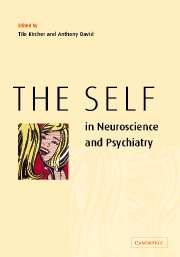Book contents
- Frontmatter
- Contents
- List of contributors
- Introduction: the self and neuroscience
- Part I Conceptual background
- Part II Cognitive and neurosciences
- 5 The multiplicity of consciousness and the emergence of the self
- 6 Asynchrony, implicational meaning and the experience of self in schizophrenia
- 7 Self-awareness, social intelligence and schizophrenia
- 8 The neural correlates of self-awareness and self-recognition
- 9 Autonoetic consciousness
- 10 The neural nature of the core SELF: implications for understanding schizophrenia
- Part III Disturbances of the self: the case of schizophrenia
- 11 Self and schizophrenia: a phenomenological perspective
- 12 Self-disturbance in schizophrenia: hyperreflexivity and diminished self-affection
- 13 The self-experience of schizophrenics
- 14 The paranoid self
- 15 Schizophrenia and the narrative self
- 16 Self-narrative in schizophrenia
- 17 Schizophrenia as disturbance of the self-construct
- 18 Action recognition in normal and schizophrenic subjects
- 19 Disorders of self-monitoring and the symptoms of schizophrenia
- 20 Hearing voices or hearing the self in disguise? Revealing the neural correlates of auditory hallucinations in schizophrenia
- 21 The cognitive neuroscience of agency in schizophrenia
- 22 Self-consciousness: an integrative approach from philosophy, psychopathology and the neurosciences
- References
18 - Action recognition in normal and schizophrenic subjects
from Part III - Disturbances of the self: the case of schizophrenia
Published online by Cambridge University Press: 18 December 2009
- Frontmatter
- Contents
- List of contributors
- Introduction: the self and neuroscience
- Part I Conceptual background
- Part II Cognitive and neurosciences
- 5 The multiplicity of consciousness and the emergence of the self
- 6 Asynchrony, implicational meaning and the experience of self in schizophrenia
- 7 Self-awareness, social intelligence and schizophrenia
- 8 The neural correlates of self-awareness and self-recognition
- 9 Autonoetic consciousness
- 10 The neural nature of the core SELF: implications for understanding schizophrenia
- Part III Disturbances of the self: the case of schizophrenia
- 11 Self and schizophrenia: a phenomenological perspective
- 12 Self-disturbance in schizophrenia: hyperreflexivity and diminished self-affection
- 13 The self-experience of schizophrenics
- 14 The paranoid self
- 15 Schizophrenia and the narrative self
- 16 Self-narrative in schizophrenia
- 17 Schizophrenia as disturbance of the self-construct
- 18 Action recognition in normal and schizophrenic subjects
- 19 Disorders of self-monitoring and the symptoms of schizophrenia
- 20 Hearing voices or hearing the self in disguise? Revealing the neural correlates of auditory hallucinations in schizophrenia
- 21 The cognitive neuroscience of agency in schizophrenia
- 22 Self-consciousness: an integrative approach from philosophy, psychopathology and the neurosciences
- References
Summary
Abstract
The ability to attribute an action to its proper agent and to understand its meaning when it is produced by someone else are basic aspects of human social communication. Several psychiatric symptoms, such as those of schizophrenia, relate to a dysfunction of the awareness of one's own action as well as of recognition of actions performed by others. Such syndromes thus offer a framework for studying the determinants of the sense of agency, which ultimately allows one to attribute correctly actions to their veridical source. This chapter will report a series of experiments in normal subjects and schizophrenic patients dealing with the recognition of actions. The basic paradigm used in these experiments was to present the subject with simple actions which may or may not correspond to those they currently execute. Systematic distortions have been introduced, such that the threshold for accepting an action as one's own could be determined. In normal subjects, this threshold is relatively high, indicating the existence of a specific mode of processing for action signals, independent from visual processing used in other perceptual activities. In schizophrenic patients, this threshold is further increased, with a strong tendency to self-attribute actions which do not correspond to those they have performed. The results reveal a clear distinction between patient groups with and without hallucinations and/or delusions of influence. Influenced patients show a higher rate of self-attributions. These results point to schizophrenia and related disorders as a paradigmatic alteration of a ‘who?’ system for action monitoring and self-consciousness.
- Type
- Chapter
- Information
- The Self in Neuroscience and Psychiatry , pp. 380 - 406Publisher: Cambridge University PressPrint publication year: 2003
References
- 12
- Cited by



